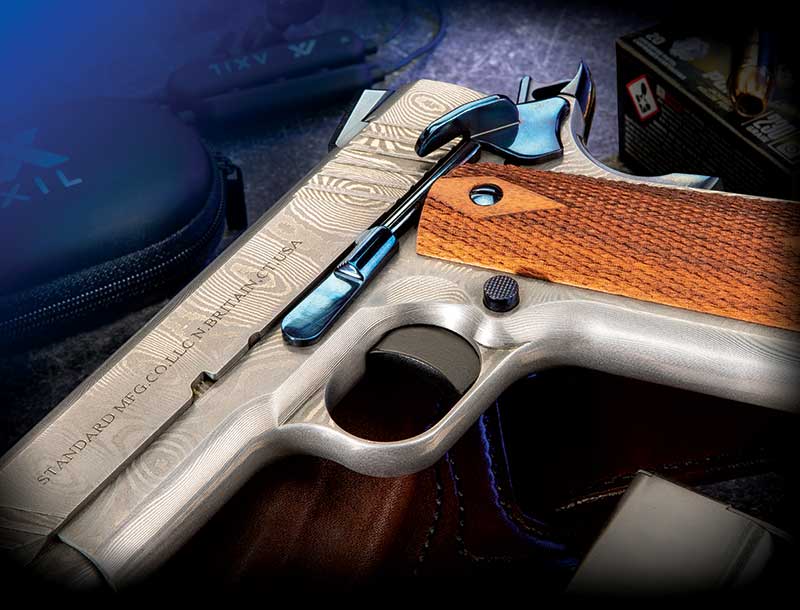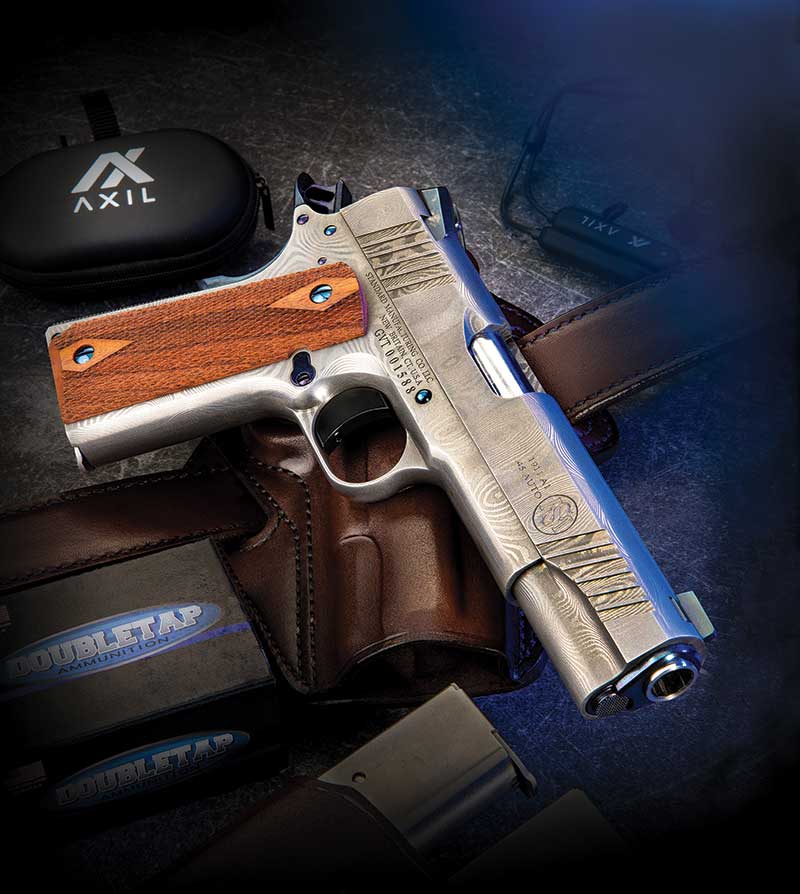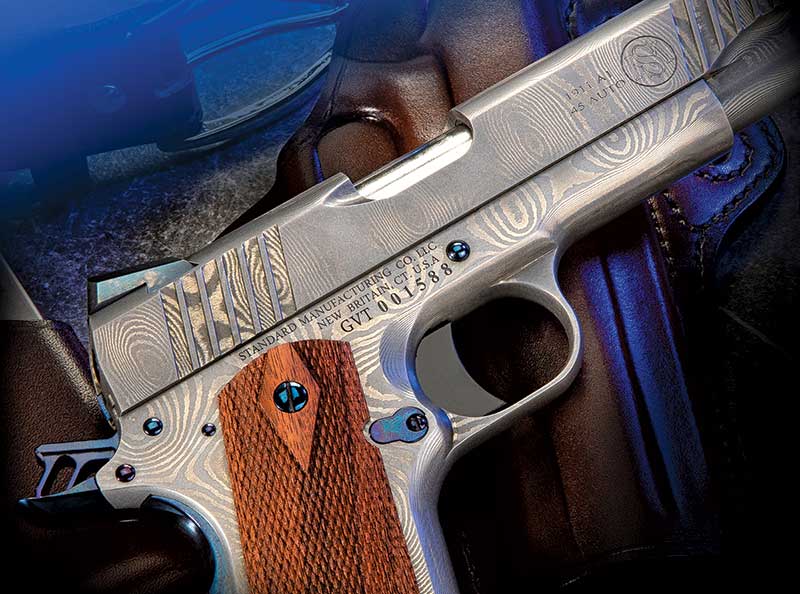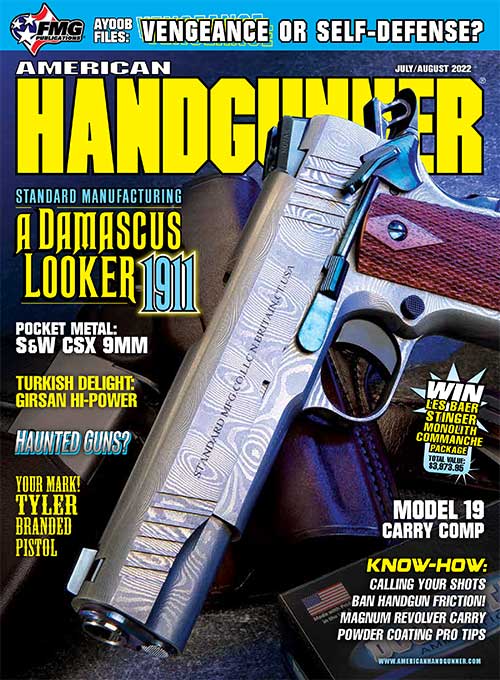Running the Standard Manufacturing Damascus 1911 Through the Gunsite Academy Gauntlet
Shooting a pretty pistol is like taking the Mona Lisa out on a date to see what that smile is all about. And make no mistake, Standard Mfg.’s Damascus 1911 is a very pretty pistol. The controls are nitre blued, in a nod back to the earliest 1911s, while both the slide and frame are made of finely grained Damascus steel, a callback to even more ancient craftsmanship. The effect is striking, with the pistol looking grey from a distance until you’re close enough to see the tight whorls and fine veins of silver and charcoal, with the sapphire of the controls adding a dramatic contrast.
The first question with a firearm at this price point — it runs a cool $6,000 — is what you’re paying for, and that varies. With an engraved pistol from the Colt Custom Shop, you’re paying for the eye and experience of the man who takes a chisel and hammer to the gun and coaxes inexpressible beauty from otherwise ordinary steel. With a Turnbull gun, you’re buying careful, historically correct bluing and surface preparation, which can take a skilled artisan a week to do by hand. A Cabot pistol is priced based on the stunning precision with which each part is willed into being, and a Pete Single gun is the result of meticulous individual welding, machining and blueprinting that rivals a race engine. On the Standard, you’re purchasing the rare material and the beauty.
Layers Of Beauty
Damascus steel was created before the advent of modern metallurgy to combine metal that was tough but unable to hold an edge with a different metal capable of maintaining a fine cutting surface but at the cost of brittleness.
Imagine heating them yellow hot, pounding them together, then folding them and doing it, again and again, resulting in a blade composed of many thin layers of mixed steel stronger and sharper than each material would be by itself. Steel alloys have developed beyond the need for this process, but the beauty of Damascus, which is acid etched to show off the grain and the evident skill required to forge it well, keep it in demand as a custom knife material.
Precious few handguns, however, have been made from Damascus, and for good reason. It’s very expensive, and the traditional forging method, while more than adequate for a blade, may not have the homogeneity and strength to withstand the sort of thousand natural shocks all pistols are heir to. This has been overcome by using Damasteel and newer forging techniques capable of producing something safely usable on a gun, such as the chain-pattern 4140 forging used on this one.
A Precise Bluing Process
Nitre bluing, also known as fire bluing, is, strictly speaking, also no longer necessary for performance purposes. Like color case hardening, the brilliant blue was originally an artifact of the heat treating/bluing process rather than the end goal. Now appreciated for its aesthetics, getting the deep blue color requires carefully submerging the part in several-hundred-degree bluing solution until the steel goes from yellow to the desired shade of blue, something which can happen very suddenly.
It’s hard to reach the desired brilliant sapphire without overbluing; the time required varies from part to part and can be hard to predict, but they did it very well on the Standard pistol. Even the Novak sights have been polished and nitre blued, though I would have bead-blasted the rear-facing portions of the sight blade and rear notch for a crisper sight picture.
The nitred grip screws have been regulated, so their screw slots line up, pointing down the centerline of the grips. Though not common on handguns, regulated screws are a common custom feature on high-end long guns, such as the classic sporting shotguns made by Standard’s sister company Connecticut Shotgun. While nitre blue is known as a finish that wears quickly, I did not notice any appreciable thinning during the short, but concentrated time I spent with the test gun.
Performance Criteria
All of this talk of value, of course, presupposes a certain level of function: If a gun doesn’t work well, it’s hard to like it (there’s a parallel here to certain Italian cars, but I will pass lightly over it), and that standard varies depending on which class the gun is in.
Most service pistols are not as accurate as 1911s. Revolvers are often more accurate and good .22s can generally embarrass the lot. Based on my experience, I expect a 1911 to average 3″ or better from a Ransom Rest with everything I stuff in it. Most high-end 1911s shoot 2″ or tighter and I’ve seen plenty that average in the 1″ range. I also expect it to run all the time. Contrary to social media myths, the 1911 is quite reliable. Remember, it went 6,000 rounds without a malfunction prior to its adoption by the U.S. Army. Having established the tune with which beauty’s beat must harmonize, on with the show.
DoubleTap ammunition provided 500 rounds of .45 ACP 200-grain match full metal jacket. I had the opportunity to burn it all through the Standard during a multi-day event at Gunsite, during which I never cleaned or oiled it. In deference to the gun’s finish — it is, after all, somebody else’s several-thousand-dollar gun — I did not work it in and out of a holster. In every other way, I rode it hard and sent it home sooty and shot from 10 yards to 200 (not a typo), fast, slow, offhand, left hand, etc.
For Special Occasions?
One thing at the outset: This does not appear to be intended as a carry pistol. Few people carry a gun at this price point and there are too many sharp edges, which is my most significant criticism of the test pistol I had. Were you to carry it, I think your clothing would find the corners soon enough, and I have a very expensive stack of torn Brooks Brothers shirts and suit jackets to inform that opinion. That said, however, the gun never scratched or cut me while shooting, and I ran it quite hard. This included multiple modified iterations of the El Presidente drill, which requires six double taps on three targets with a mandatory reload. My best time was a respectable 10 seconds and change. While I am used to guns with aggressively textured frontstraps, the smooth frontstrap of the Standard pistol presented no control problems and gave a slightly larger canvas to show off the grain of the Damascus.
Rode Hard
I also ran through the Scrambler outdoor simulator with it, a multi-station course of fire with steel rifle targets ranging from 60 to just beyond 100 yards. For our event, several handgun targets were added in the 20-yard range. As per the rules, you get two tries at each target. I shot both the rifle and pistol targets, missing only one, and once the drill was completed, I finished with a pair of back-to-back offhand hits on a 100-yard Pepper Popper, shooting old-school bullseye style with one hand.
Have mercy; this thing will shoot and straight to the point of aim. The extended safety is can’t-miss fast, recoil is soft with the wide beavertail, and that brilliant blue slotted hammer drops with the speed of intention. My best 25-yard group was a full mag I put into about 31/2″. More than once, I was able to call a particular bullet hole in the target and then cut it with a single shot at 10 yards, once tracking five consecutive rounds into a beautiful horizontal slit. I struggled at 100 yards to find the holdoff until I realized it didn’t need any. I did better after that, hence the two one-handed hits on the Scrambler.
Function
I mostly used the two 7-round Metalform magazines it came with, as well as Wilson 7-round Series 47 mags I happened to have with me. As expected, the gun never failed to feed. Starting around the 300-round mark, though, it would intermittently fail to go all the way into battery, needing a little thumb pressure to get the slide all the way forward.
The gun did not have excessively tight tolerances and could be easily field stripped without a bushing wrench, which is the way I was taught to build a 1911. Oiling it likely would have helped, but I think a stronger recoil spring is in order, especially for those like me who go long periods without cleaning.
Trigger Time
And what a trigger. Dave Fink, the onsite gunsmith at Gunsite, was kind enough to measure the pull, and it broke cleanly and consistently at an average of 3 lbs., 7 oz. While the 1911 can mechanically be a very accurate pistol, the trigger is one of the most important mechanisms for delivering this accuracy in a human hand. It’s one of the best features of the design and they very much got it right on this one.
I tend to be critical when evaluating 1911s; it’s the platform I’ve spent the most time with and inside of. There are things I’d change on the Standard gun, which I’ve already mentioned, including the walnut grip panels that appear to be laser checkered. A gun of this caliber just deserves better. In the final analysis, though, this gun does exactly what it’s supposed to do. It handles and shoots well and looks gorgeous in the process.
You may find a pistol that’s a different kind of pretty, but you won’t find one any prettier, nor are you likely to find another Damascus pistol in this price range. And don’t be afraid to take her to the range. I think you’ll like what you find behind the smile.
Special thanks to Gunsite Academy and instructors Lew Gosnell and Aimee Grant. For more info: StdGun.com, DoubleTapAmmo.com, Gunsite.com












